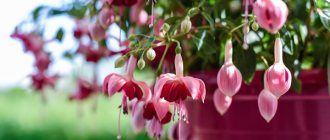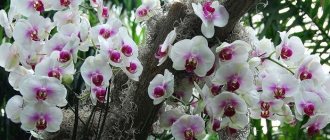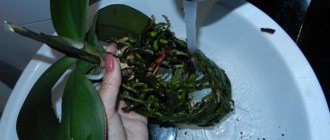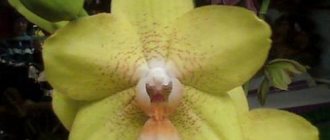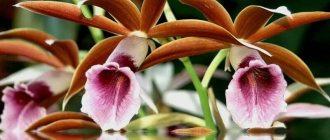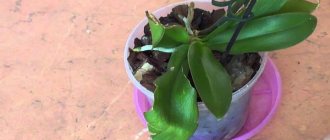Studying the structure of plants is the job of botanists. But in the case of orchids, it doesn’t hurt to figure out what their root system, leaves and flowers are. This is necessary in order to succeed in growing these tropical beauties.
The structure of phalaenopsis, dendrobium, paphiopedilum or cymbidium orchids is not so different from traditional indoor flowers. Orchids also have a trunk (stem), roots, leaves and flowers. But we cannot help but mention the characteristic features inherent only to these amazing tropical epiphytes, which have gained incredible popularity among flower growers.
Diagram of the structure of the phalaenopsis orchid
The structure of an orchid differs from other indoor plants in appearance, so the flower requires certain knowledge of care and cultivation. Before purchasing phalaenopsis, you should familiarize yourself in detail with the structure of the plant, features of care and breeding. An orchid consists of a root system, stem (trunk), leaves and the flower itself.
Roots
The root system has some differences depending on the type of orchid. However, in any case, it performs the following functions:
- with its help, the flower is attached to the substrate or trees, rocks in the natural environment;
- participates in plant photosynthesis;
- absorbs water and nutrients.
Some types of orchids may have aerial roots. One of the representatives of such a flower is the phalaenopsis orchid.
stem
All members of the family are divided into two groups depending on the method of branching of the shoot. If the shoot has only one growth point and develops upward, then this method is called monopodial. When the shoot develops in a horizontal direction, we can talk about the sympodial method of branching. Thus, the stem of an orchid is essentially a vertical shoot. It can be both long and short.
Leaves
Orchid leaves vary in shape, color and structure. It depends on the type of plant and habitat. Orchids growing in the shade have thin leaves, while those in the sun have thicker leaves with a dense structure. Often the leaves reach 1 meter in length. During the dry period, they absorb water and accumulate it in the leaves, thereby adapting to difficult environmental conditions.
Flower
The orchid flower is extremely beautiful, its structure is quite complex. The bright and wide elements of the flower are sepals (sepalia) modified over time. Their shape, color and size depend on the type of plant. Sepals alternate with petals, which are petals, and differ in color. In the very center of the flower there is a formation that is found only in orchids - the lip or labellum. Its function is to attract pollinating insects to the flower.
Stem
Phalaenopsis belongs to the monopodial type of orchid. Its trunk is short, consists of leaves and grows only upward, has one single growth point.
If the peduncle appears from the growth point, then growth stops there. In place of the socket, children will form; all that remains is to wait until the children grow up and are ready for transplantation.
Where is the root collar of Phalaenopsis?
Very often they write about the root collar of phalaenopsis. For example:
“When planting orchids, make sure that the root collar does not go deep into the ground.”
What is a root collar?
ROOT NECK is the junction of the root and the stem, where the vascular bundles of the underground part of the plant pass into the above-ground parts.
Phalaenopsis simply cannot have it due to its structure. Firstly, it is an epiphyte. Secondly, its roots grow throughout the stem and even between the leaves.
Root system
The root system is an important part of the flower, which performs a number of complex functions. The roots are usually white. They consist of a special substance, velamen, which contains dead cells and is filled with air. This structure of the root system resembles a sponge and helps the plant accumulate water and develop in unfavorable conditions. The longer the drought, the thicker the plant’s velamen layer. Flower roots can be primary or adventitious.
Main
The main type of orchid root system can be seen in a pot, since this plant is grown in a transparent container. When purchasing, you need to pay attention to the roots: they should not contain mold or rot.
Subordinate clause
The accessory type of phalaenopsis root system is also called aerial. Such roots can grow on any part of the plant. With their help, the orchid attaches itself to nearby crops, without interfering with their development, that is, without parasitizing at their expense. These plants are called epiphates. For some reason, they cannot establish themselves in the soil and obtain nutrients through photosynthesis. The leaves and roots of the orchid take part in this process. Thanks to adventitious roots, the plant is able to absorb moisture directly from the air. Externally, such roots appear as thick shoots.
Care
The orchid is native to tropical forests with a humid and hot climate. In our latitudes, orchids need additional care, otherwise problems with the beauty’s well-being will immediately arise.
- Wipe the leaves regularly with a damp cloth to remove dust.
- It is advisable to spray the flower 5 times a day. Avoid the procedure during the flowering period.
- Use clean, filtered water at a temperature of 35-40ºС.
- Humidity within 50-60%. Be sure to regularly ventilate the room.
- The plant loves a warm shower, but water should not stagnate in the leaf axils, otherwise there is a risk of disease.
- You should not place the pot in a window with bright sunlight; the rays can leave thermal burns on the leaves.
- Lighting is required diffused, with a daylight duration of 14 hours.
- For active growth and rich leaf color, it is recommended to use nitrogen-based fertilizers.
- Visually inspect foliage weekly for insect damage.
Flower
An orchid flower is formed from a peduncle that grows from a certain axil between the leaves and the trunk of the plant. The peduncle changes annually; indoors it grows in autumn or spring. If at some point the formation of a peduncle does not occur, this often means that the orchid does not have enough sun and light. The peduncle dries out after the flowers fall.
A distinctive feature of the phalaenopsis flower is its central symmetry, when the six parts of the flower are arranged in two circles. The flowers have a variety of shapes, ranging in size from 1 to 20 cm.
Division into types
Scientists have been engaged in the classification of orchids since the 18th century , with the first works of the Swedish naturalist Carl Linnaeus.
The latest and most current classification system was developed by Roberts Dressler in 1981. Orchids according to this system are divided according to the structure of the column (fused stamen and pistil) and the nature of the location of the anther (part of the stamen containing pollen) and stigma (formation at the top of the pistil).
The orchid family is divided into 5 subfamilies:
- apostasiaceae (primitive orchids common in Southeast Asia);
- Cypripediaceae (another name is “Venus’s slippers”; they live in the tropics, subtropics and temperate zones of America, Asia and Europe);
vanilla (the family got its name due to the famous spice, which is extracted from the fruits of the Vanilla flatifolia orchid; it is widely represented in tropical Africa, Asia and America);- orchids themselves (common both in the tropics and in forests of temperate latitudes);
- epidendritic (or “tree-living”; have a wide habitat, these include almost all known decorative epiphytic orchids).
Representatives of the “vanilla” subfamily are the only orchids that have agricultural value.
Pseudobulb
Bulbs are certain formations that are found only in orchids of the sympodial type. This is a reduced shoot that collects moisture and nutrients. The pseudobulb is the same, but is formed in an ovoid, oval, cylindrical shape, while the bulb resembles an onion. Despite the fact that these formations are not shoots of the plant, sometimes buds, leaves and even aerial roots appear on them.
Deviations in color
Of course, all deviations from the green tint are not the norm for orchids.
- Yellow color may indicate wilting, drying of foliage, as well as improper care and overdose of mineral fertilizers.
- Purple color - leaves are damaged by sunlight. Overheating in intense light or thermal burns can cause a similar effect.
- A reddish, brown tint may appear as a result of excess lighting.
- But the black, dark brown color indicates that the orchid is susceptible to infectious diseases, in particular rot.
How to wake up a sleeping kidney
The bud in a dormant state is located on the peduncle, at its base or in the middle. If it can be awakened artificially, then a full-fledged orchid baby can be raised.
Before starting work, you need to determine the temperature in the room. It must be at least 22°C. On the peduncle in its middle part, select about 4 nodes and cut off the scales with a knife. Lubricate the cleaned kidney with any drug that accelerates growth. After about a month, small rosettes consisting of 2-3 leaves should appear in this place. Later, roots appear on them and when they reach 2 cm, the baby needs to be cut off and transplanted into a transparent pot with substrate. Under favorable conditions and proper care, the orchid will bloom within a year.
Is it possible and how to determine the color of an orchid by its leaves?
Recently, the popularity of orchids has been gaining momentum, and therefore many hybrid varieties of the crop have begun to appear. However, it is at least approximately possible to determine the color of the future flower. For example, if the leaves on both sides are light in color, then most likely the flower will be white or yellow. If the inner side is purple or burgundy, then the bud will appear in bright, rich colors.
If the plates change structure, color, density, spots, tubercles, plaques develop on them, then it is necessary to establish the exact cause of these phenomena, then begin treatment.
Plant propagation
The reproduction process can be performed in two ways.
Propagation from seeds
Through seeds it is possible to develop new varieties and species. The method of propagation by seeds is used by breeders. Seeds are not difficult to obtain, but getting the orchid to grow and bloom correctly is very difficult. Many people order seeds from China for this purpose. However, such planting material is most often characterized by low quality.
Division of Phalaenopsis by children
The growth points at which the appearance of babies can be observed are represented by leaf axils or dormant buds on peduncles. Such growth points are called meristems. There are several ways to stimulate the formation of children in order to perform the division of Phalaenopsis. The most common practice is to place cut flower stalks in closed transparent mini-greenhouses. The division of Phalaenopsis by children can be stimulated by reducing watering and temperature changes, including cold and very warm stress indicators. Dividing Phalaenopsis by cutting the peduncles into several parts with the presence of dormant growth points.
Phalaenopsis is the most unpretentious orchid plant that is grown in indoor floriculture. The plant produces flowers on an old peduncle and does not require pollination. New flower stalks are formed all year round. Even beginners can grow it, and the temperature conditions should be in the range of eighteen to twenty-five degrees, which is easy to maintain at home.
Banana peel fertilizer
There is a widespread belief online that banana fertilizer is very miraculous and effective for many flowering plants, including orchids.
But no matter how they prepare it, and mostly like mash. I would like to warn orchid lovers and give the correct recipe for banana fertilizer:
- 4 banana peels
- 1 tablespoon sugar
- 1 liter of water
How to make banana peel fertilizer: Boil for about 20 minutes. Let cool. Strain through two or three layers of gauze. Water orchids by immersion. Once every two weeks, no more often.
There is no need to infuse the mash, and do not forget to strain, otherwise your orchids will receive nothing but a breeding ground for bacteria and fungi.
What it is?
A peduncle is a shoot of a plant that grows from the base of the orchid upward, presented in the form of a long curved spike. It got its name due to the fact that later flowers begin to grow on it.
However, when it first appears, beginners in floriculture often confuse it with the root of a plant or its baby . In fact, this is a mistake made by inexperienced flower growers; these parts still have differences; let’s take a closer look at what they are next.
